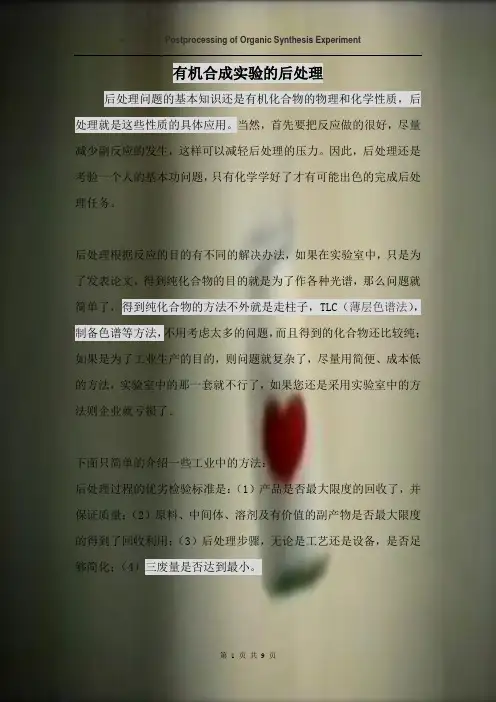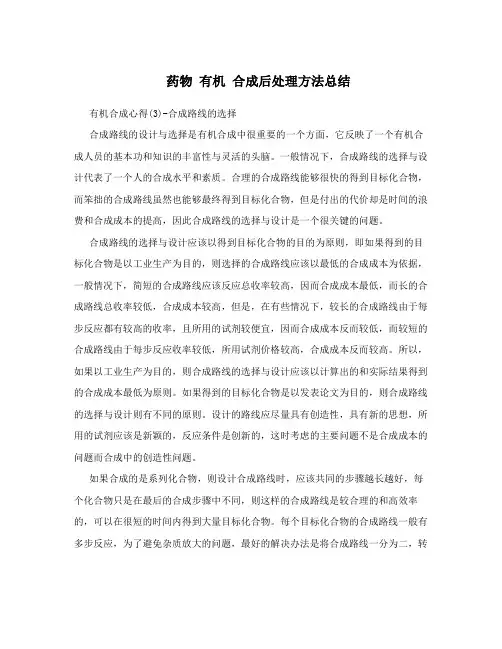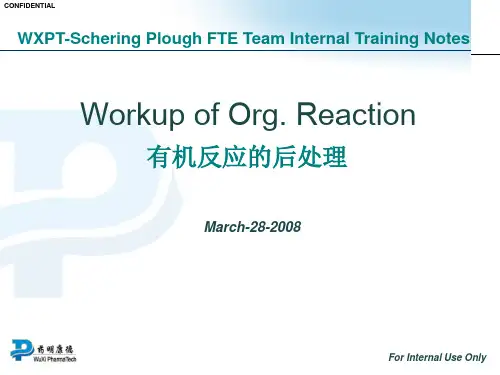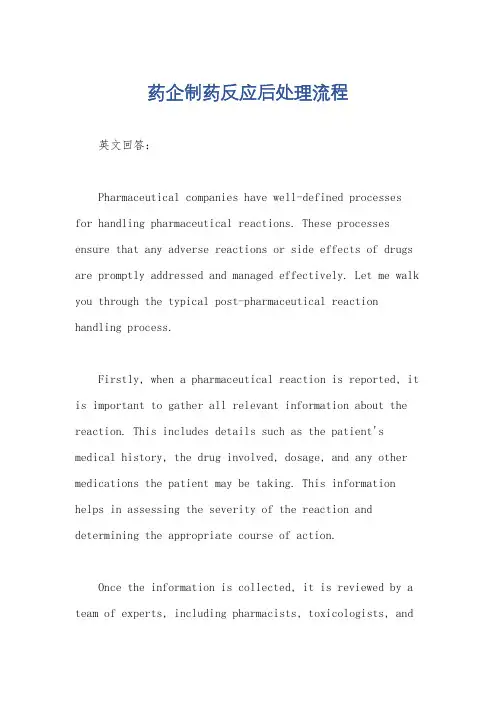药明康德有机反应的后处理共27页
- 格式:ppt
- 大小:4.02 MB
- 文档页数:27


有机合成实验的后处理后处理问题的基本知识还是有机化合物的物理和化学性质,后处理就是这些性质的具体应用。
当然,首先要把反应做的很好,尽量减少副反应的发生,这样可以减轻后处理的压力。
因此,后处理还是考验一个人的基本功问题,只有化学学好了才有可能出色的完成后处理任务。
后处理根据反应的目的有不同的解决办法,如果在实验室中,只是为了发表论文,得到纯化合物的目的就是为了作各种光谱,那么问题就简单了,得到纯化合物的方法不外就是走柱子,TLC(薄层色谱法),制备色谱等方法,不用考虑太多的问题,而且得到的化合物还比较纯;如果是为了工业生产的目的,则问题就复杂了,尽量用简便、成本低的方法,实验室中的那一套就不行了,如果您还是采用实验室中的方法则企业就亏损了。
下面只简单的介绍一些工业中的方法:后处理过程的优劣检验标准是:(1)产品是否最大限度的回收了,并保证质量;(2)原料、中间体、溶剂及有价值的副产物是否最大限度的得到了回收利用;(3)后处理步骤,无论是工艺还是设备,是否足够简化;(4)三废量是否达到最小。
后处理的几个常用而实用的方法:(1)有机酸(碱)性化合物的分离提纯具有酸碱性基团的有机化合物,可以得失质子形成离子化合物,而离子化合物与原来的母体化合物具有不同的物理化学性质。
碱性化合物用有机酸或无机酸处理得到胺盐,酸性化合物用有机碱或无机碱处理得到钠盐或有机盐。
根据有机化合物酸碱性的强弱,有机、无计酸碱一般为甲酸、乙酸、盐酸、硫酸、磷酸。
碱为三乙胺、氢氧化钠、氢氧化钾、碳酸钠、碳酸氢钠等。
在一般情况下,离子化合物在水中具有相当大的溶解性,而在有机溶剂中溶解度很小,同时活性碳只能够吸附非离子型的杂质和色素。
利用以上的这些性质可对酸碱性有机化合物进行提纯。
以上性质对所有酸碱性化合物并不通用,一般情况下,分子中酸碱性基团分子量所占整个分子的分子量比例越大,则离子化合物的水溶性就越大,分子中含有的水溶性基团例如羟基越多,则水溶性越大,因此,以上性质适用于小分子的酸碱化合物。

药物有机合成后处理方法总结有机合成心得(3)-合成路线的选择合成路线的设计与选择是有机合成中很重要的一个方面,它反映了一个有机合成人员的基本功和知识的丰富性与灵活的头脑。
一般情况下,合成路线的选择与设计代表了一个人的合成水平和素质。
合理的合成路线能够很快的得到目标化合物,而笨拙的合成路线虽然也能够最终得到目标化合物,但是付出的代价却是时间的浪费和合成成本的提高,因此合成路线的选择与设计是一个很关键的问题。
合成路线的选择与设计应该以得到目标化合物的目的为原则,即如果得到的目标化合物是以工业生产为目的,则选择的合成路线应该以最低的合成成本为依据,一般情况下,简短的合成路线应该反应总收率较高,因而合成成本最低,而长的合成路线总收率较低,合成成本较高,但是,在有些情况下,较长的合成路线由于每步反应都有较高的收率,且所用的试剂较便宜,因而合成成本反而较低,而较短的合成路线由于每步反应收率较低,所用试剂价格较高,合成成本反而较高。
所以,如果以工业生产为目的,则合成路线的选择与设计应该以计算出的和实际结果得到的合成成本最低为原则。
如果得到的目标化合物是以发表论文为目的,则合成路线的选择与设计则有不同的原则。
设计的路线应尽量具有创造性,具有新的思想,所用的试剂应该是新颖的,反应条件是创新的,这时考虑的主要问题不是合成成本的问题而合成中的创造性问题。
如果合成的是系列化合物,则设计合成路线时,应该共同的步骤越长越好,每个化合物只是在最后的合成步骤中不同,则这样的合成路线是较合理的和高效率的,可以在很短的时间内得到大量目标化合物。
每个目标化合物的合成路线一般有多步反应,为了避免杂质放大的问题,最好的解决办法是将合成路线一分为二,转化为两个中间体,最后将两个中间体通过一步反应组装起来得到目标化合物。
尽量避免连续反应只在最后一步得到产物。
有机合成心得(4)-有机反应的实质有机合成的任务是运用已知的或可能的化学反应来形成C-C键或C-杂键,从而将两个或多个分子或离子连接起来。


经典化学合成反应标准操作药明康德新药开发有限公司化学合成部编写前言有机合成研究人员在做化学反应经常碰到常规的反应手边没有现成的标准操作步骤而要去查文献,在试同一类反应时,为了寻找各种反应条件方法也得去查资料。
为了提高大家的工作效率,因此化学合成部需要一份《经典合成反应标准操作》。
在这份材料中,我们精选药物化学中各类经典的合成反应,每类反应有什么方法,并通过实际经验对每类反应的各种条件进行点评,供大家在摸索合成条件时进行比较。
同时每种反应的标准操作,均可作为模板套用于书写客户的final report,这样可以大大节省研究人员书写final report的时间,也相应减少在报告中的文法错误。
另外本版是初版,在今后的工作中我们将根据需要修订这份材料。
药明康德新药开发有限公司化学合成部2005-6-28目录1.胺的合成a)还原胺化b)直接烷基化c)腈的还原d)酰胺的还原e)硝基的还原f)叠氮的还原g)Hoffman降解h)羧酸通过Cris 重排2.羧酸衍生物的合成a)酰胺化的反应b)酯化反应c)腈转化为酯和酰胺d)钯催化的插羰反应e)酯交换为酰氨3.羧酸的合成a)醇氧化b)酯水解c)酰胺的水解d)腈的水解e)有机金属试剂的羰基化反应f)芳香甲基的氧化4.醛酮的合成a)Weinreb 酰胺合成醛酮b)醇氧化c)酯的直接还原d)有机金属试剂对腈加成合成酮5.脂肪卤代物的合成a)醇转化为脂肪溴代物通过PBr3 转化通过PPh3 与CBr4 转化HBr直接交换通过相应的氯代物或磺酸酯与LiBr交换、b)醇转化为脂肪氯代物通过SOCl2转化通过PPh3 与CCl4 转化HCl直接交换c)醇转化为脂肪碘代物通过PPh3 与I2 转化通过相应的氯代物或磺酸酯与NaI交换6.芳香卤代物的合成a)Sandermyyer 重氮化卤代b)直接卤代c)杂环的酚羟基或醚的卤代7.醇的合成a)羧酸或酯的还原b)醛酮的还原c)卤代烃的水解d)吡啶的氧化转位8.酚的合成a)Sandermayer 重氮化反应b)醚的水解c)Bayer-vigerlar 氧化d)硼酸的氧化9.腈的合成a)磺酸酯或卤代烃的取代b)酰胺的脱水c)芳卤代烃的氰基取代10.硝化反应11.醚的合成a)芳香醚的合成酚与烷基卤代烃的直接烷基化Mitsunobu 芳香醚化Buckwald芳香醚化b)脂肪醚的合成醇的醚化12.脲的合成a)胺与异腈酸酯的反应b)用三光气合成脲c)羰基二咪唑(CDI)合成脲d)对硝基苯酚碳酰胺合成脲13.烯烃的合成a)Wittig 反应b)羟基的消除c)Wittig-Horner 反应合成α,β-不饱和酯14.磺酸及磺酰氯的合成a)氯磺化反应合成磺酰氯b)从硫醇合成磺酰氯c)磺化反应15.氨基酸的合成a)Streck 反应合成b)手性氨基酸的合成16.偶联反应a)Suzuki Couplingb)Buckwald 芳胺化,芳酰胺化、c)Heck 反应17.Mitsunobu 反应a)醇的反转b)胺的取代18.脱羟基反应19.酮还原为亚甲基20.氨的保护及脱保护策略a)用碳酰胺作保护基b)苄基保护21.醇的保护及脱保护策略a)用硅醚进行保护b)其他醚类保护22.羧基的保护格氏反应---------------------------------------------------------------------------------------------------------1还原胺化---------------------------------------------------------------------------------------------------------2卤化反应---------------------------------------------------------------------------------------------------------2 Suzuki coupling-------------------------------------------------------------------------------------------------2磺化反应---------------------------------------------------------------------------------------------------------3酯化反应---------------------------------------------------------------------------------------------------------3水解反应---------------------------------------------------------------------------------------------------------3硝化反应---------------------------------------------------------------------------------------------------------4 n-BuLi------------------------------------------------------------------------------------------------------------4 LiAlH4还原-----------------------------------------------------------------------------------------------------4 POCl3的杂环氯代----------------------------------------------------------------------------------------------5 NaH---------------------------------------------------------------------------------------------------------------5 NBS---------------------------------------------------------------------------------------------------------------5m-CPBA ----------------------------------------------------------------------------------------------------------6EDC ---------------------------------------------------------------------------------------------------------------6用三光气成脲---------------------------------------------------------------------------------------------------7芳卤用n-BuLi 处理后与Weinreb 酰胺成酮-----------------------------------------------------------------7Boc 上保护OHH 2NHO OOOOOO OHN HO OHO O ABTo a solution of A (2.72 g, 13.9 mmol) and tetramethylammonium hydroxide pentahydrate (5.62 g, 31.0 mmol) in acetonitrile (270 mL) was added di-tert-butyldicarbonate (3.79 g; 17.4 mmol) and the resulting solution was allowed to stir 18 h at rt and concentrated. The residue was partitioned between Et2O/H2O; the phases were separated and the aqueous phase extracted twice more with Et2O. The aqueous phase was brought to pH 4 with solid citric acid and extracted with CHCl3 (3.x.100 mL). The organic extracts were combined, dried (Na2SO4) and concentrated to afford 2.58 g (63 percent) B as a white foam.ReturnBoc 脱保护OON HOOOOH 2NTert-Butyl 2-(2-methoxyphenoxy)ethylcarbamate (23.8 g, 89 mmol) in dichloromethane (10 ml) was cooled to 0 deg C and stirred as a mixture of trifluoroacetic acid: dichloromethane (1:1, 40 ml) was added dropwise. The mixture was allowed to warm to rt, stirred for 2 hours and concentrated in vacuo. The residue was taken back up in dichloromethane (100 ml) and the solution was washed with saturated aqueous sodium hydrogen carbonate (3*20 ml) and aqueous sodium hydroxide (10percent, 3*20 ml), dried (Na2SO4), filtered and concentrated in vacuo to provide 2-(2-methoxyphenoxy)ethylamine (13 g, 88percent yield) as a light yellow solid.Return格氏反应NCNNOA stirred mixture of magnesium turnings (23.6 g, 0.98 mol) and Et2O (200 mL) under nitrogen is treated with a crystal of iodine and about 5percent of a solution of bromoethane (56.3 ml, 0.75 mol) in Et2O (375 mL). When the reaction starts, the remainder of the bromoethane solution is added, dropwise at a rate sufficient to maintain a gentle reflux. After the addition, stirring is continued for 1 hour. To this solution of ethylmagnesium bromide was slowly added a solution of 4-cyanopyridine (39 g, 0.375 mol) in Et2O (750 ml). The reaction mixture was warmed at reflux for 12 hours, treated with concentrated H2SO4 (125 ml)/H2O (125 ml), and then washed three times with Et2O (250 ml). The aqueous portion was made basic (PH 9) with 15percent NaOH solution and extracted five times with 250 ml portions of Et2O. The combined Et2O extracts were dried (MgSO4), and the solvent was removed under reduced pressure to afford a brown oil (48.4 g, 95percent).Return还原胺化OHO H 2N+HON HA solution of 2-amino-4-ethylphenol (1.00 g. 7.28 mmol), 2-naphthaldehyde (1.13 g, 7.28 mmol), andp-toluenesulfonic acid (0.05 g) in methanol (50 ML) was stirred at room temp for 24 h. To the resultant solution, sodium borohydride (0.82 g, 22 mmol) was added in small portions. After addition was completed, the mixture was stirred at room temperature for 30 min and concentrated under vacuum. The residue was then subjected to column chromatography on silica gel eluted with 10percent ethyl acetate in hexane and followed by recrystallization (aqueous methanol) yielded 450 mg (22percent) of analytically pure product.Return卤化反应O2N O2NBrTo a stirred solution of 8-methyl-1-nitro-naphthalene (10.6g, 56.32 mmol) and iron (III) chloride (0.45 g, 2.77 mmo) in CCl4 (150 ml) heated to 60°C was added dropwise (3.0 ml, 58.23 mmol) of bromine. After one hour, the reaction mixture was poured into saturated NaHCO3 solution, and the layers were separated. The aqueous layer was re-extracted with CH2Cl2. The combined organic layers were dried (MgSO4) and the solvent was removed under reduced pressure. The crude residue was recrystallized from ethanol and the mother liquors were concentrated and then flash chromatographed on silica, eluding hexanes:ethyl acetate (12: 1).ReturnSuzuki couplingBrBOO NH+NH To a mixture of 4-(4,4,5,5-tetramethyl-[1,3,2]dioxaborolan-2-yl)-1H-indole (2 g, 8.2 mnmol) and3-bromobenzene (0.87 ml, 8.3 mmol) in THF (28 ml) were added palladium catalyst Pd(PPh3)4 (284 mg, 0.25 mmol) and the freshly prepared sodium hydroxide solution (984 mg in 9 ml of water).The system was degassed and then charged with nitrogen for three times. The mixture was stirred under nitrogen at 70 °Coil bath for 6 hours. The reaction solution was cooled to room temperature, diluted with ethyl acetate and separated from water layer. The ethyl acetate solution was washed by brine, dried over Na2SO4 and concentrated. The residue was purified on a silica gel column eluding with hexanes: EtOAc 9:1 to give 1.38 g (78%yield) of 4-phenyl-1H-indole as a colorless liquid.Return磺化反应NOFFFNOFFFSOClOChlorosulfonic acid (4.66g, 40 mmol) is added dropwise to a cold (0°C) solution of2,3-dihydro-2-trifluoroacetyl-1H-Benz[de]isoquinoline (2.9g, 8 mmol) in chloroform (800 ml). The resulting solution is stirred at 0°C for 30 minutes. The cold bath is then removed and the solution is stirred at room temperature for 1 hour then cautiously poured into ice water. The organic layer is separated, dried over magnesium sulfate and concentrated to afford the title compound. The crude product is purified by column chromatography eluted with 10% acetic ether in petroleum ether (2.36 g, 81% yield).Return酯化反应HOHO O HOO OA mixture of 4-hydroxymethylnaphthoic acid (10 g, 50 mmol), methanol (300 ml), and concentrate H2SO4(2 ml) was refluxed overnight. The insolubles were filtered off and the filtrate was concentrated. The residue was taken up in ethyl acetate and washed with aqueous NaHCO3 (2*), brine, dried over MgSO4, and concentrated to give a yellow oil. Silica gel column chromatography using ethyl acetate/hexane (1/3) gave the desired product as a yellow oil (3.3 g, 35%yield).Return水解反应OO OHOA solution of 1-Methyl-naphthalene-2-carboxylic acid methyl ester (7.20g, 35mmol) and 2N sodium hydroxide (35ml) in tetrahydrofuran (130ml) was stirred under reflux for 18 hours. The mixture was neutralised using 2N hydrochloric acid, and extracted with dichloromethane (3x). The combined organic solutions were dried (MgSO4), and evaporated under reduced pressure. The crude product was purified by column chromatography on silica gelusing an elution gradient of dichloromethane: methanol (100:0 to 97:3) to afford the title compound as a solid (3.11g, 47.8%yield).Return硝化反应NO 2To a cold (0°C) suspension of 1-methylnaphthalene (5 g, 35.2 mmol) in HNO3 was added H2SO4 (5 ml) dropwise. After stirring the reaction for one hour, the solution was diluted with ethyl acetate and washed with water (3*), aqueous saturated NaHCO3 (2*) and brine, dried over MgSO4, and concentrated. The product was purified by silica gel column chromatography using ethyl acetate: hexane (5: 95) and recrystallized from methanol to give yellow needles (0.22g, 33% yield).Returnn-BuLiEtOCF 3O CF 3O NCTo a dry three-necked round-bottomed flask with an addition funnel and at -78°C under inert atmosphere was charged with anhydrous THF (500 ml). A solution of n-butyllithium (2.5 M in hexane, 88ml, 220 mmol) was added dropwise followed by addition of a solution of acetonitrile (10.43 ml, 200 mmol) in anhydrous THF (100 ml). The internal temperature was maintained below -70°C during the entire addition process. After 2 hr at -78°C a solution of Trifluoro-acetic acid ethyl ester (14.2 g, 100 mmol) in anhydrous THF (30 ml) was added dropwise and the mixture was stirred for 1.5 hr. To the mixture was added acetic anhydride to quench the reaction. The reaction mixture was allowed to warm up to rt. A precipitate was filtered and the filtrate was concentrated to give a brown oil, which was used in the next step without purification.ReturnLiAlH4还原HOHO O OHOHOA solution of 2,3-naphthalenedicarboxylic acid (4.6 g, 0.023 mole) in dry THF (135 ml, warmed to 50° to maintain solution) is added dropwise over 15 minutes to a 1.15 M lithium aluminum hydride solution in THF (45 ml, 0.052 mole). The solution is stirred 3 hours after which TLC indicated consumption of diacid and formation of a new major product. The reaction is quenched carefully with THF-water, then 2N hydrochloric acid (40 ml) is added, and the resulting mixture is extracted 3 times with ether. The combined ether extracts are washed with water (2 times), with saturated sodium bicarbonate solution (1 time), with water, and are dried (sodium sulfate), filtered, and concentrated to give a tan solid (3.67 g). The solid is recrystallized from ethyl acetate giving the title compound (2.91 g, 67.3%yield) as a light tan crystalline material.ReturnPOCl3的杂环氯代NN HOOHN NClClTo a suspension of 2,4-dihydroxy-5,6-dimethylpyrimidine (6.2 g, 0.044 mol) in POCl3 (25 ml) was slowly added N,N-dimethylaniline (6.18 ml, 0.049 mol). The mixture was then refluxed at 125 °C for 3 hours. After this time, the starting material completely dissolved indicating that the reaction was completed.The reaction mixture was cooled and then poured slowly onto ice to quench the POCl3(caution[exothermic]). A precipitate formed, which was filtered and washed with ice-cold water. The precipitate was dried under high vacuum overnight to yield 2,4-dichloro-5,6-dimethyl-pyrimidine (7.2 g, 0.041 mol, 92%yield) as a yellow solid.ReturnNaHHSH 2N Cl +SNH 2Sodium hydride (50% in mineral oil, 5.5 g, 0.11 mol) was added portionwise at 0 °C under a nitrogen atmosphere to a solution of 2-aminobenzenethiol (12 ml, 0.1 mol) in DMF (120 ml). After 0.5 h, benzyl chloride (11.5 ml, 0.1 mol) in DMF (80 ml) was added in 0.5 h. The solution was stirred for 3 h while the temperature was allowed to rise to rt, then it was poured into ice/water (1000 g). The precipitate was filtered, dissolved in ethyl acetate and washed with brine. The organic layer was dried over Na2SO4 and evaporated. The solid obtained was ground in pentane (19.3 g, 90% yield).ReturnNBSNN FCl ClNBSN N FCl ClBrA mixture of 2,4-Dichloro-6-ethyl-5-fluoro-pyrimidine (27.46 g , 0.14mol), AIBN (1.32 g) and n-bromosuccinimide (27.02 g , 0.152mol) in CH2Cl2 (170 ml) was refluxed under a nitrogen atmosphere for 36 h. Then washed by water, the aqueous was extracted by CH2Cl2. The combined organic layer was washed by saturated Na2S2O3 and brine, dried over Na2SO4, and evaporated to give a white solid which was purified by column chromatography eluted with 50% acetic ether in petroleum ether (34 g, 88.6% yield).Return氢化反应O ONH OONH2Cl ClA mixture of ethyl 3-(N-benzylamino)-3-methylbutyrate hydrochloride (25g, 0.1 mol) and 10percent Pd-C (2g) in 250 ml of dried alcohol was hydrogenated under 55 psi H2 for four days. The reaction medium was then filtered and evaporated under reduced pressure to provide an amber oil which gradually crystallized upon standing (18 g, 100% yield).Returnm-CPBAS NH2SNH2OA solution of 85% m-chloroperoxybenzoic acid (19 g, 94 mmol) in CH2Cl2 (350 ml)was added at –5 –0 °C to a solution of 2-Benzylsulfanyl-phenylamine (19 g, 88 mmol) in CH2Cl2 (400 ml). The mixture was allowed to warm to rt in 3 h, then it was washed with a 5% Na2S2O3 solution, 10% NaHCO3 solution and brine. The organic layer was dried over Na2SO4, and evaporated. The solid was ground in pentane (19 g, 95% yield).ReturnEDCNH2OHNOO+HOHOHNOOTo a 0°C mixture of Boc-L-tyrosine (2.04 g, 7.26 mmol) and amylamine (0.63 gl, 7.26 mmol) in methylene chloride (30 ml) is added 1-(3-dimethylaminopropyl)-3-ethylcarbodiimide (EDC) (1.53 g, 9.9 mmol). Thewhite mixture is stirred at 0°C for 5 min and at room temp for 23 hrs. The resulting solution is diluted with methylene chloride (30 ml) and washed successively with 0.5 M HCl (40 ml), water (20 ml) and sat aq sodium bicarbonate (25 ml). The organic phase is dried over magnesium sulfate and concentrated to a foam (1.84 g, 72.4%yield), sufficiently pure to carry into the next step. An analytical sample is obtained by HPLC.Return三光气成脲NH 2ONO 2Si O Cl Cl ClO O Cl Cl ClO 2NHN H NO OHOHNO 2+To a solution of 2-(tert-butyldimethylsilyloxy)-4-nitroaniline (200 mg, 0.75 mmol) in toluene (10 ml) triethylamine (0.13 ml, 1.64 mmol) and triphosgene (88.4 mg, 0.3 mmol) were added. The reaction mixture was stirred at 70 °C for 2 hours, then cooled to room temperature. Then more 2-(tert-butyldimethylsilyloxy)-4-nitroaniline (200 mg, 0.75 mmol) was added. The resulting mixture was allowed to stir at 70 °C for 48 hours then cooled to room temperature. The reaction mixture was partitioned between water and ethyl acetate. The combined organic phase was washed with brine, dried over MgSO4 and filtered. Removal of solvent at reduced pressure and chromatography of the resulting oil on silica gel (hexane: ethyl acetate, 10:1) gave 1,3-Bis-(2-hydroxy-4-nitro-phenyl)-urea (130 mg, 31%yield).Return芳卤用n-BuLi处理后与Weinreb酰胺成酮N FFFFNOO+FFFO NFTo a solution of diisopropylamine (17.69 ml, 0.135 mole) in THF (200 ml) at –78°C under argon was added n-butyllithium (54.0 ml, 2.5M in hexane, 0.135 mole), followed after 5 min by dropwise a solution of 2-fluoro-4-methylpyridine (10 g, 0.090 mole) in THF (20 ml). After stirring for 15 min at –78°C, a solution of N-methoxy-N-methyl-3-trifluoromethylbenzamide (23.08 g, 0.099 mole) in THF (10 ml) was added dropwise. After stirring for more 5 min, the reaction was allowed to warm to 0°C and quenched by pouring into water (400 ml) and ethyl acetate (400 ml). The layers were separated, and the aqueous layer washed with ethyl acetate (200 ml). The ethyl acetate extracts were combined, dried over anhydrous sodium sulfate, filtered, and concentrated to an oil which was chromatographed on silica gel with 20percent ethyl acetate in hexane to give 21.6 g of 2-(2-Fluoro-pyridin-4-yl)-1-(3-trifluoromethyl-phenyl)-ethanone (84.8%yield).Return。


Mitsunobu-反应经典化学合成反应标准操作Mitsunobu 反应编者:谢军药明康德新药开发有限公司化学合成部目录1.前言 (2)2.醇的翻转 (3)2.1 Mitsunobu 法醇的构型翻转合成方法示例 (7)3.Mitsunobu 醚化反应 (8)3.1 Mitsunobu 法醚的合成方法示例 (9)4.Mitsunobu 氨基取代反应 (10)4.1 Mitsunobu 法利用苯磺酰胺合成胺方法示例 (13)4.2 Mitsunobu 法利用DPPA合成伯胺方法示例 (13)4.3 Mitsunobu 法分子内关环合成相应的环状胺方法示例 (14)4.4 Mitsunobu 法合成丙二烯方法示例 (14)5.Mitsunobu 硫代反应 (16)5.1 Mitsunobu 法合成硫醚方法示例 (16)6.Mitsunobu 卤代反应 (18)6.1 Mitsunobu 法合成卤代物方法示例 (18)7.其他手性翻转试剂 (20)1. 前言1967年,Oyo Mitsunobu 报导了在三苯膦(PPh3)和偶氮二甲酸二乙酯(DEAD)作用下酸和醇缩合成酯的新方法1。
当底物为仲醇的时候,与羟基相连的碳原子的构型会发生翻转。
经过多年的研究和发展,形成了一大类合成方法,我们称之为Mitsunobu 反应。
这类反应被广泛应用在有机合成,特别是天然产物的合成中2。
2.醇的翻转在Mitsunobu 反应中,DEAD 和三苯膦首先生成一个活性的甜菜碱式中间体(betaine intermediate ),这个活性中间体夺取作为亲核试剂的酸的质子并同时活化醇,随后经过S N 2取代,得到手性翻转的酯;将得到的酯水解,其净结果是醇的构型翻转。
R O R OH Ar O23反应在很温和的条件下进行,通常反应温度是在0o C 到室温,大部分基团都不会影响反应。
但亲核试剂质子的pKa 值必须小于甜菜碱式中间体(betaine intermediate )的pKa 值(~13),否则亲核试剂的质子不能被中间体(betaine intermediate )夺取,反应不能进行。



经典化学合成反应标准操作Suzuki 反应编者:刘德军、武伟药明康德新药开发有限公司化学合成部目录1 前言 (3)1.1 Suzuki反应的通式 (3)1.2 Suzuki反应的机理 (3)1.3 Suzuki反应的特点及研究方向 (4)2 有机硼试剂的合成 (4)2.1 通过金属有机试剂制备单取代芳基硼酸 (4)2.1.1 通过Grinard试剂制备单取代芳基硼酸示例 (4)2.1.2 通过有机锂试剂制备单取代芳基硼酸示例 (5)2.2 通过二硼烷频哪酯制备芳基硼酸酯 (6)2.2.1 通过二硼烷频哪酯制备芳基硼酸酯示例(一) (9)2.2.2 通过二硼烷频哪酯制备芳基硼酸酯示例(二) (10)2.2.3 通过芳基硼酸转化为芳基硼酸酯 (10)2.3 烯基硼酸酯的制备 (10)2.4 烷基硼酸酯的制备 (10)3 催化剂的制备 (11)3.1 Pd(PPh3)4的制备 (11)3.2 Pd(PPh3)2Cl2的制备 (12)3.3 Pd(dppf)Cl2的制备 (12)4Suzuki偶联的应用 (12)4.1 普通的芳卤和芳基硼酸的Suzuki偶联 (13)4.1.1 Pd(PPh3)4-Na2CO3-DME-H2O 体系Suzuki偶联反应示例 (14)4.2 大位阻芳基硼酸参与Suzuki偶联反应 (14)4.3 含敏感功能团的芳基硼酸(酯)参与Suzuki偶联反应 (15)4.3.1 芳基硼酸频哪酯和芳基卤代物的Suzuki偶联 (16)4.3.2 带着酯基底物的Suzuki偶联反应示例(一) (16)4.3.3 带着酯基底物的Suzuki偶联反应示例(二) (17)4.4 杂环芳基硼酸参与Suzuki偶联反应 (17)4.5烷基硼酸参与Suzuki偶联反应 (18)4.6烯基硼酸参与Suzuki偶联反应 (19)4.7 Triflate参与Suzuki偶联反应 (19)4.7.1芳基的三氟甲基磺酸酯与芳基硼酸偶联示例 (20)4.7.2 芳基的Triflate与芳基硼酸偶联示例 (20)4.8 芳基氯参与Suzuki偶联反应 (21)4.8.1钯催化下芳基氯参与Suzuki偶联反应示例(一) (21)4.8.2钯催化下芳基氯参与Suzuki偶联反应示例(二) (22)4.9 镍催化体系用于Suzuki偶联反应 (22)4.9.1 NiCl2(dppf)和n-BuLi催化下芳基氯参与Suzuki偶联反应示例 (22)4.10 其他方法 (23)4.10.1 直接Pd/C用于Suzuki偶联反应示例 (23)4.10.2 直接Pd(OAc)2用于Suzuki偶联反应示例 (23)1 前言1.1 Suzuki 反应的通式在钯催化下,有机硼化合物与有机卤素化合物进行偶联反应,这就提供了一类常用和有效的合成碳-碳键化合物的方法,我们称之为Suzuki 偶联反应,或Suzuki-Miyaura 偶联反应。

药企制药反应后处理流程英文回答:Pharmaceutical companies have well-defined processesfor handling pharmaceutical reactions. These processes ensure that any adverse reactions or side effects of drugs are promptly addressed and managed effectively. Let me walk you through the typical post-pharmaceutical reaction handling process.Firstly, when a pharmaceutical reaction is reported, it is important to gather all relevant information about the reaction. This includes details such as the patient's medical history, the drug involved, dosage, and any other medications the patient may be taking. This information helps in assessing the severity of the reaction and determining the appropriate course of action.Once the information is collected, it is reviewed by a team of experts, including pharmacists, toxicologists, andmedical professionals. They analyze the data to understand the cause and potential implications of the reaction. This analysis helps in determining the appropriate steps to be taken.Based on the severity of the reaction, different actions may be taken. In cases of mild reactions, such as minor skin rashes or gastrointestinal discomfort, the patient may be advised to discontinue the medication and seek symptomatic relief. The reaction is then documented for future reference and monitoring.For more serious reactions, such as severe allergic reactions or life-threatening side effects, immediate medical intervention is necessary. The patient may be referred to a healthcare facility for further evaluation and treatment. In such cases, it is crucial to ensure the patient's safety and well-being.In addition to addressing the immediate concerns, pharmaceutical companies also have a responsibility to report and document adverse reactions. These reports aresubmitted to regulatory authorities, such as the FDA in the United States, to contribute to drug safety monitoring and surveillance. This information helps in identifying patterns and trends in drug reactions and enables regulatory agencies to take appropriate actions, such as issuing warnings or recalls.Furthermore, pharmaceutical companies often conduct post-marketing surveillance studies to monitor the long-term safety and effectiveness of their drugs. These studies involve collecting data from real-world patients to assess any potential risks or benefits that may not have been identified during clinical trials. The findings from these studies can influence the labeling, dosage recommendations, or even the withdrawal of a drug from the market if necessary.Overall, the post-pharmaceutical reaction handling process involves thorough assessment, appropriate medical intervention, documentation, reporting, and ongoing monitoring. It is crucial for pharmaceutical companies to have robust systems in place to ensure the safety and well-being of patients using their medications.中文回答:药企在处理药物反应时有着明确的流程。
药物有机合成后处理方法总结有机合成心得(3)-合成路线的选择合成路线的设计与选择是有机合成中很重要的一个方面,它反映了一个有机合成人员的基本功和知识的丰富性与灵活的头脑。
一般情况下,合成路线的选择与设计代表了一个人的合成水平和素质。
合理的合成路线能够很快的得到目标化合物,而笨拙的合成路线虽然也能够最终得到目标化合物,但是付出的代价却是时间的浪费和合成成本的提高,因此合成路线的选择与设计是一个很关键的问题。
合成路线的选择与设计应该以得到目标化合物的目的为原则,即如果得到的目标化合物是以工业生产为目的,则选择的合成路线应该以最低的合成成本为依据,一般情况下,简短的合成路线应该反应总收率较高,因而合成成本最低,而长的合成路线总收率较低,合成成本较高,但是,在有些情况下,较长的合成路线由于每步反应都有较高的收率,且所用的试剂较便宜,因而合成成本反而较低,而较短的合成路线由于每步反应收率较低,所用试剂价格较高,合成成本反而较高。
所以,如果以工业生产为目的,则合成路线的选择与设计应该以计算出的和实际结果得到的合成成本最低为原则。
如果得到的目标化合物是以发表论文为目的,则合成路线的选择与设计则有不同的原则。
设计的路线应尽量具有创造性,具有新的思想,所用的试剂应该是新颖的,反应条件是创新的,这时考虑的主要问题不是合成成本的问题而合成中的创造性问题。
如果合成的是系列化合物,则设计合成路线时,应该共同的步骤越长越好,每个化合物只是在最后的合成步骤中不同,则这样的合成路线是较合理的和高效率的,可以在很短的时间内得到大量目标化合物。
每个目标化合物的合成路线一般有多步反应,为了避免杂质放大的问题,最好的解决办法是将合成路线一分为二,转化为两个中间体,最后将两个中间体通过一步反应组装起来得到目标化合物。
尽量避免连续反应只在最后一步得到产物。
有机合成心得(4)-有机反应的实质有机合成的任务是运用已知的或可能的化学反应来形成C-C键或C-杂键,从而将两个或多个分子或离子连接起来。